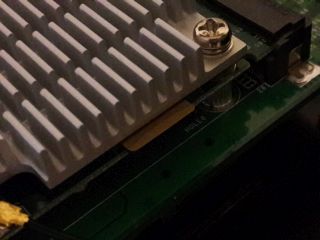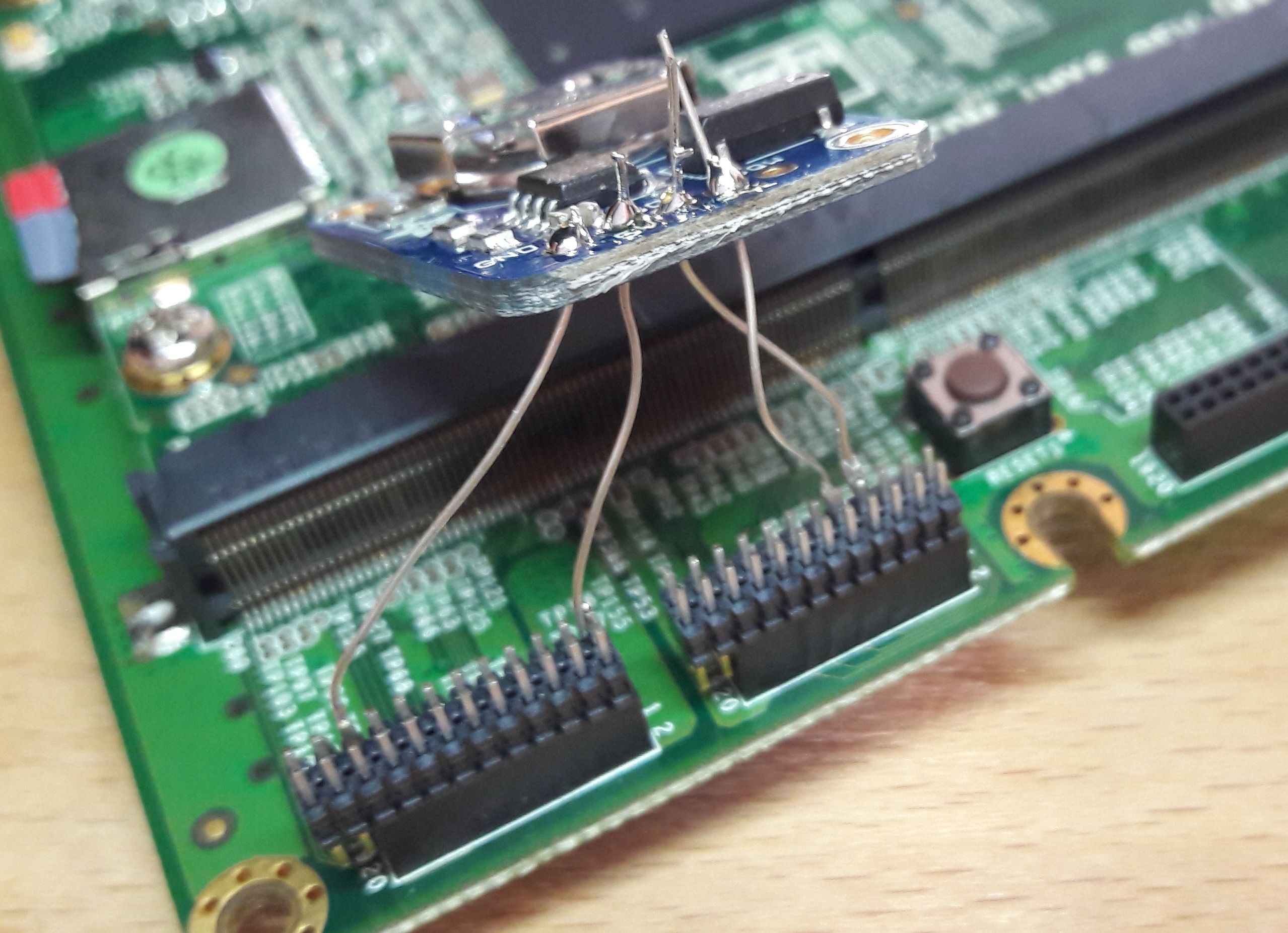
My SD card image can be downloaded here.
Please use the upper SD card slot at the Wandboard:

Installed/used software
from LFS:
Linux kernel headers 5.4.162, Man-pages-5.13, Iana-Etc-20211124, Glibc-2.34, Zlib-1.2.11, Bzip2-1.0.8, Xz-5.2.5, Zstd-1.5.0, File-5.41, Readline-8.1, M4-1.4.19, Bc-5.2.1,
Flex-2.6.4, Tcl-8.6.11, Expect-5.45.4, DejaGNU-1.6.3, Binutils-2.37, GMP-6.2.1, MPFR 4.1.0, MPC 1.21, Attr-2.5.1, Acl-2.3.1, Libcap-2.61, Shadow-4.9,
Pkg-config-0.29.2, Ncurses-6.3, Sed-4.8, Psmisc-23.4, Gettext-0.21, Bison-3.8.2, Grep-3.7, Bash-5.1.8, Libtool-2.4.6, GDBM-1.22, Gperf-3.1,
Expat-2.4.1, Inetutils-2.2, Less-590, Perl-5.34.0, XML::Parser-2.46, Intltool-0.51.0, Autoconf-2.71, Automake-1.16.5, Kmod-29, Libelf from Elfutils-0.186,
Libffi-3.4.2, OpenSSL-1.1.1l, Python-3.10.0, Ninja-1.10.2, Meson-0.60.2, Coreutils-9.0, Check-0.15.2, Diffutils-3.8, Gawk-5.1.1, Findutils-4.8.0,
Groff-1.22.4, Gzip-1.11, IPRoute2-5.15.0, Kbd-2.4.0, Libpipeline-1.5.4, Make-4.3, Patch-2.7.6, Tar-1.34, Texinfo-6.8, Vim-8.2.3704, Eudev-3.2.10,
Man-DB-2.9.4, Procps-ng-3.3.17, Util-linux-2.37.2, E2fsprogs-1.46.4, Sysklogd-1.5.1, Sysvinit-3.00
additional software:
isl 0.24, which 2.21, GCC 11.2.0 (with enabled languages c,c++,d,fortran,go,objc,obj-c++), libtasn1 4.18.0,
p11-kit 0.24.0, make-ca 1.9, libunistring 0.9.10, libidn2 2.3.2, libpsl-0.21.1, pcre2 10.39, wget 1.21.2, cpio 2.13, joe 4.6, nano 5.9,
net-tools 2.10 (and from there additional ifconfig because this knows IPv6), traceroute 2.1.0, tree 1.8.0, libtirpc 1.3.2,
lsof 4.94.0, iptables 1.8.7, lynx 2.8.9rel.1, LZO 2.10, lzop 1.04, time 1.9, libnl 3.5.0, curl 7.80.0, rpcbind 1.2.6, git 2.34.1, dhcpcd 9.4.1, libxml 2.9.12,
wireless tools 29, wpa_supplicant 2.9, openssh 8.8p1, htop 3.1.1, iotop 1.20, screen 4.8.0, Net::SSLeay-1.90, URI-5.10, IO::Socket::SSL-2.072 , sntp and ntpdate from ntp 4.2.8p15,
uboot (via git checkout, see below), linux kernel 5.4.154 with Wandboard patches (see below)
cat > ~/.bashrc << "EOF" set +h umask 022 LFS=/mnt/lfs LC_ALL=POSIX LFS_TGT=armv7l-lfs-linux-gnueabihf PATH=/tools/bin:/bin:/usr/bin export LFS LC_ALL LFS_TGT PATH EOFChapter 5.5.1 Installation of Glibc:
case $(uname -m) in
i?86) ln -sfv ld-linux.so.2 $LFS/lib/ld-lsb.so.3
;;
x86_64) ln -sfv ../lib/ld-linux-x86-64.so.2 $LFS/lib64
ln -sfv ../lib/ld-linux-x86-64.so.2 $LFS/lib64/ld-lsb-x86-64.so.3
;;
armv7l) ln -sfv ld-linux.so.3 $LFS/lib/ld-lsb.so.3
;;
esac
Chapter 7.7.1 Installation of Target Libstdc++
../libstdc++-v3/configure \
CXXFLAGS="-g -O2 -D_GNU_SOURCE" \
--prefix=/usr \
--disable-multilib \
--disable-nls \
--host=armv7l-lfs-linux-gnueabihf \
--disable-libstdcxx-pch
Chapter 9.6.2 Configuring Sysvinit#Serial c0:12345:respawn:/sbin/agetty 115200 ttymxc0 vt100Hint: on the Wandboard, ttymxc0 is the serial line, not ttyS0
Chapter 9.6.5 Configuring the Linux Console
After trying a boot with the new LFS, it stopped with this error message:
*****Setting up Linux console... [ FAIL ]
***** [ FAIL ]
FAILURE:
You should not be reading this error message.
It means that an unforeseen error took place in
/etc/rc.d/rcS.d/S70console,
which exited with a return value of 1.
If you're able to track this error down to a bug in one of
the files provided by the LFS book,
please be so kind to inform us at lfs-dev@linuxfromscratch.org (Registration required).
***** [ FAIL ]
Press Enter to continue...
After pressing Enter to system continues to boot. But usually you have not a serial console connected and you will never see this message.# Begin /etc/sysconfig/console UNICODE="1" KEYMAP="de-latin1" KEYMAP_CORRECTIONS="euro2" #LEGACY_CHARSET="iso-8859-15" # Removed, with this enabled the console init script stops FONT="LatArCyrHeb-16 -m 8859-15" # End /etc/sysconfig/console
git clone -b v2019.04 https://github.com/u-boot/u-boot --depth=1 cd u-boot/ wget -c https://github.com/eewiki/u-boot-patches/raw/master/v2019.04/0001-wandboard-uEnv.txt-bootz-n-fixes.patch patch -p1 < 0001-wandboard-uEnv.txt-bootz-n-fixes.patch make distclean make wandboard_defconfig makeYou should find now two files: SPL and u-boot.img. Assume your SD card is /dev/sdb, install U-Boot with this commands (as root):
dd if=/dev/zero of=/dev/sdb bs=1M count=10 dd if=SPL of=/dev/sdb seek=1 bs=1k dd if=u-boot.img of=/dev/sdb seek=69 bs=1kHint: if you are already on a Wandboard, the SD card might be /dev/mmcblk0 or /dev/mmcklb2
To create a partition, use the program sfdisk (as root). You should use a newer version of sfdisk (=> 2.26):
sfdisk /dev/sdb <<-__EOF__ 1M,4G,L,* __EOF__
If you are building on the Wandboard, you might add to create some swap space before:
fallocate -l 4G /swapfile chmod 600 /swapfile mkswap /swapfile mkswap: /swapfile: warning: wiping old swap signature. Setting up swapspace version 1, size = 4 GiB (4294963200 bytes) no label, UUID=67a07d2f-350e-4ca3-b388-1324bcf4a62c swapon /swapfileNow get the kernel with patches:
git clone https://github.com/RobertCNelson/armv7-multiplatform cd armv7-multiplatform/ git checkout origin/v5.4.x -b tmp ./build_kernel.shYou don't need to change anything in the configuration dialog.
At the end the kernel, modules and dtbs archive has been build. You get an overview. Example:
----------------------------- 'arch/arm/boot/zImage' -> '/sources/l/armv7-multiplatform/deploy/5.4.154-armv7-x62.zImage' '.config' -> '/sources/l/armv7-multiplatform/deploy/config-5.4.154-armv7-x62' -rwxr-xr-x 1 root root 9.8M Nov 28 20:09 /sources/l/armv7-multiplatform/deploy/5.4.154-armv7-x62.zImage ----------------------------- Building modules archive... Compressing 5.4.154-armv7-x62-modules.tar.gz... -rw-r--r-- 1 root root 23M Nov 28 20:16 /sources/l/armv7-multiplatform/deploy/5.4.154-armv7-x62-modules.tar.gz ----------------------------- Building dtbs archive... Compressing 5.4.154-armv7-x62-dtbs.tar.gz... -rw-r--r-- 1 root root 4.7M Nov 28 20:17 /sources/l/armv7-multiplatform/deploy/5.4.154-armv7-x62-dtbs.tar.gz ----------------------------- Script Complete eewiki.net: [user@localhost:~$ export kernel_version=5.4.154-armv7-x62] -----------------------------In this example the kernel version is 5.4.154-armv7-x62 Create /boot/uEnv.txt with this content:
uname_r=5.4.154-armv7-x62 console=tty0 #console=ttymxc0 #cmdline=video=HDMI-A-1:1024x768@60e cmdline=video=HDMI-A-1:1920x1080@60euname_r is the kernel that U-Boot should load. The filename must start with vmlinuz, so copy and rename the kernel:
cp -v ./deploy/5.4.154-armv7-x62.zImage /boot/vmlinuz-5.4.154-armv7-x62Install the dtbs files:
mkdir -p /boot/dtbs/5.4.154-armv7-x62/ tar -xvf ./deploy/5.4.154-armv7-x62-dtbs.tar.gz -C /boot/dtbs/5.4.154-armv7-x62/Install kernel modules (Again: you might need to modify the path, take care that you don't destroy your host system /lib! Using the -h switch for tar is recommended especially if /lib is only a symbolic link to /usr/lib like we have in newer LFS versions):
tar -hxvf ./deploy/5.4.154-armv7-x62-modules.tar.gz -C /
uname_r=5.4.154-armv7-x62 console=tty0 #console=ttymxc0 #cmdline=root=/dev/sda1 rw video=HDMI-A-1:1024x768@60e cmdline=root=/dev/sda1 rw video=HDMI-A-1:1920x1080@60e
mkdir -p /lib/firmware/brcm/ cd /lib/firmware/brcm/ wget -c https://git.kernel.org/cgit/linux/kernel/git/firmware/linux-firmware.git/plain/brcm/brcmfmac4329-sdio.bin wget -c https://git.kernel.org/cgit/linux/kernel/git/firmware/linux-firmware.git/plain/brcm/brcmfmac4330-sdio.bin wget -c https://rcn-ee.com/repos/git/meta-fsl-arm-extra/recipes-bsp/broadcom-nvram-config/files/wandboard/brcmfmac4329-sdio.txt wget -c https://rcn-ee.com/repos/git/meta-fsl-arm-extra/recipes-bsp/broadcom-nvram-config/files/wandboard/brcmfmac4330-sdio.txt
The Wandboard onboard RTC will always loose the time if powered off.
Simplest way is to set the time via NTP. But if don't want this or your
configuration has no access to a NTP server, you can add a Dallas DS1307 RTC
chip via I2C connection.
I bought a small Adafruit DS1307 board. It has five pin, but you only have
to connect four wires: +5V, GND, SDA, SCL. The board needs a CR1220 battery
to keep the time. On my first tries I inserted the battery in the wrong
direction - the DS1307 has not kept the time ;)
The I2C pins SDA and SCL are at JP2 expansion pin header, +5V and GND are at JP4. See Wandboard User Guide page 7 for information which pin is which
signal. My wiring looks bad, but it works:
 Click here to enlarge
Click here to enlarge
Finally you must the tell the system that there is a DS1307 RTC. With my minimal LFS system from above, edit /etc/rc.d/init.d/settimeviantp and add the red lines:
case "$1" in
start)
echo "try to set time via DS1307"
echo ds1307 0x68 > /sys/class/i2c-adapter/i2c-0/new_device
sleep 3
/sbin/hwclock --rtc /dev/rtc1 --hctosys
echo "Setting time via NTP from ptbtime1.ptb.de..."
sleep 10
/usr/sbin/ntpdate -s ptbtime1.ptb.de
sleep 1
;;
The echo ds1307 0x68 > /sys/class/i2c-adapter/i2c-0/new_device command is important. This tells the kernel that
there is a DS1307 device. The kernel needs to be compiled with I2C
and DS1307 RTC support.Run now /etc/rc.d/init.d/settimeviantp start
At dmesg you should see that the DS1307 recognized:
root@wandboard:~ # dmesg | grep ds1307 [ 12.591586] rtc-ds1307 0-0068: registered as rtc1 [ 12.597197] i2c i2c-0: new_device: Instantiated device ds1307 at 0x68The DS1307 is registered as rtc1, so we have to tell the hwclock command via parameter --rtc /dev/rtc1 that this should be used.
To set the time to the DS1307 RTC from the current kernel time which has been hopefully set via NTP, use:
root@wandboard:~ # hwclock --rtc /dev/rtc1 -wYou may want to create a crontab script that updates at least one time per day the time via NTP and sync to the DS1307.
If something doesn't work it is always good to check with I2C Tools. Does it see the DS1307?
root@wandboard:~ # i2cdetect -y 0
0 1 2 3 4 5 6 7 8 9 a b c d e f
00: -- -- -- -- -- -- -- -- -- -- -- -- --
10: -- -- -- -- -- -- -- -- -- -- -- -- -- -- -- --
20: -- -- -- -- -- -- -- -- -- -- -- -- -- -- -- --
30: -- -- -- -- -- -- -- -- -- -- -- -- -- -- -- --
40: -- -- -- -- -- -- -- -- -- -- -- -- -- -- -- --
50: -- -- -- -- -- -- -- -- -- -- -- -- -- -- -- --
60: -- -- -- -- -- -- -- -- 68 -- -- -- -- -- -- --
70: -- -- -- -- -- -- -- --
If you see instead of 68 only UU: you have set already the device via
settimeviantp script (echo ds1307 0x68 > /sys/class/i2c-adapter/i2c-0/new_device)Keep in mind: the Wandboard has two I2C busses, my wiring from above is on the first I2C bus, which is checked via the parameter -y 0
zurück zur Linuxübersicht
Letzte Aktualisierung dieser Seite: 23. Januar 2022